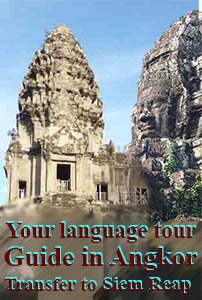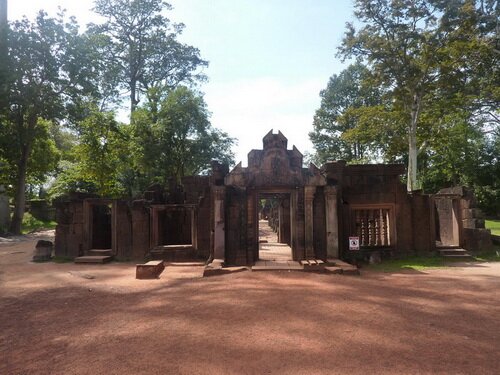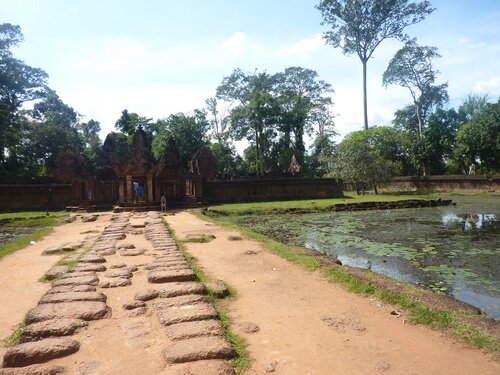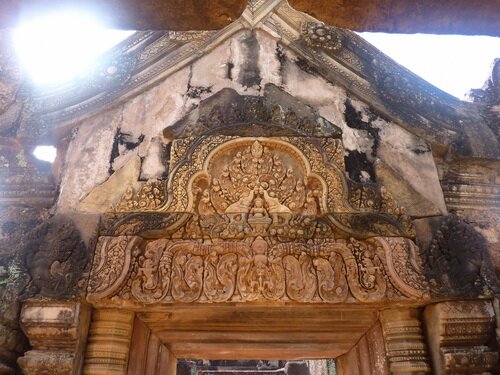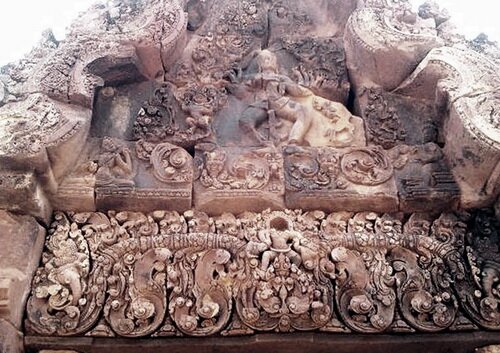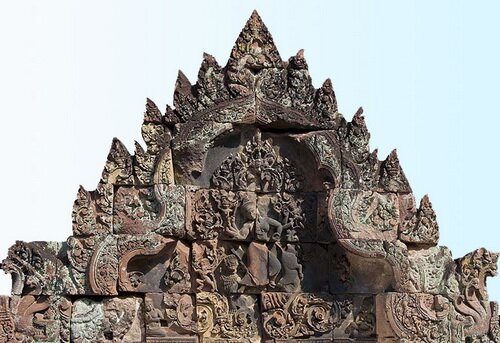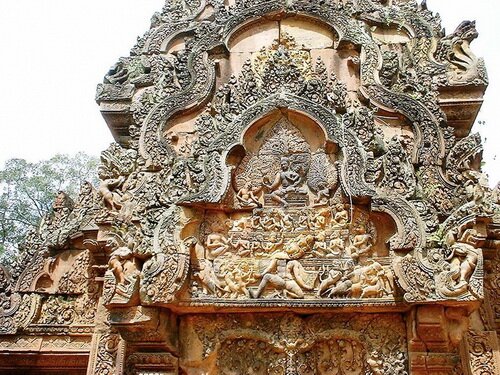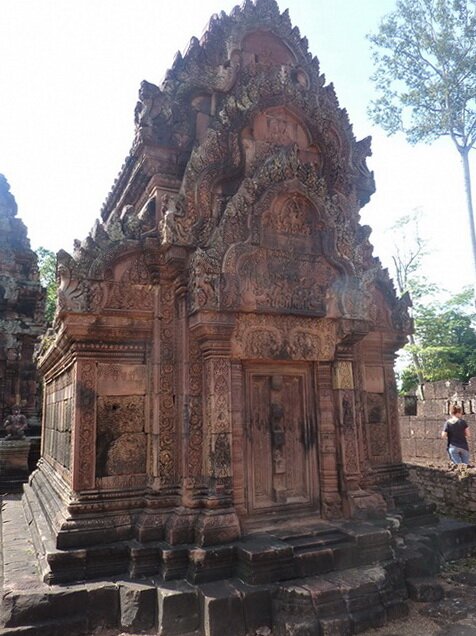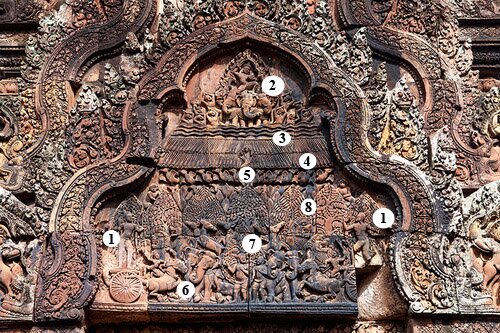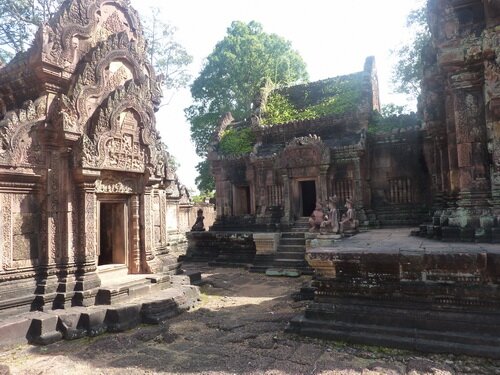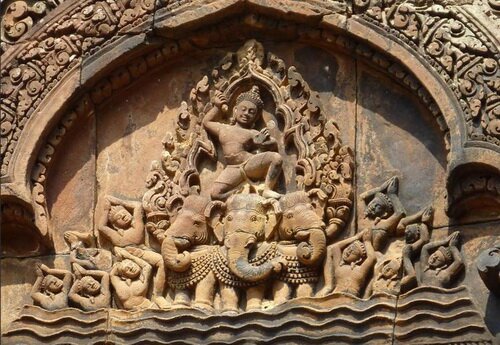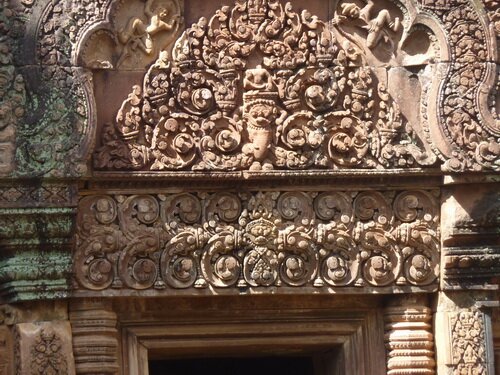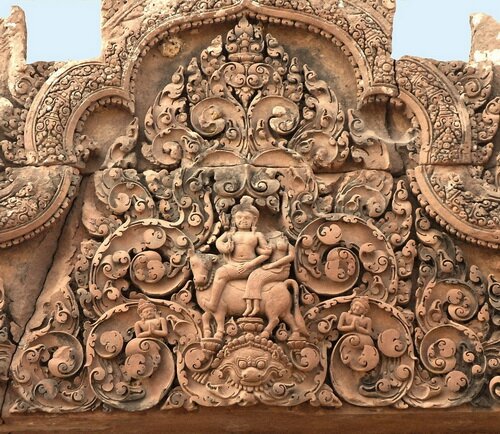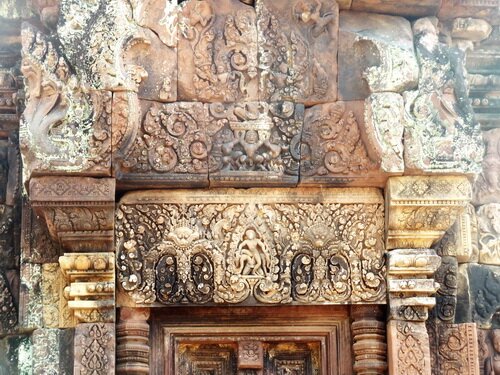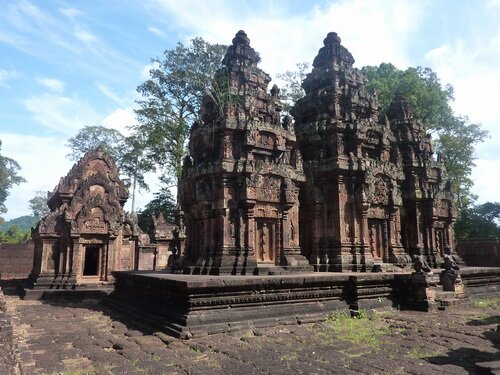

|
||||
|
|
||||
 |
||||
Banteay Sreiប្រាសាទបន្ទាយស្រីIf the symbols are not visible downlad a khmer font |
Date Second part of the X century (sanctified at 22 April 967) Built by Yajnavaraha during the reign of kings Radzhendravarman II and Jayavarman V Cult: Brahman (Shivite) Clearing H.Parmentier and V. Goloubew in 1924 with anastylosis by Henri Marchal from 1931 until 1936. |
|||
|
The name Banteay Srey relatively modern, means 'Citadel of the Women', or perhaps 'Citadel of Beauty', and presumably refers to its size and the delicacy of its decoration. The temple's actual name, taken from that of its central linga, was Tribhuvanamahesvara — 'Great Lord of the Threefold World'. Unlike the major sites at Angkor, Banteay Srei was not a royal temple. It was built by one of Rajendravarman's counsellors, Yajnavaraha, who was also the guru of the future king Jayavarman V. Yajnavaraha was granted this land on the banks of the upper Siem Reap river by the king. He and his younger brother commissioned the temple, which was finished just a year before King Rajendravarman died. As usual, a settlement surrounded the temple; in this case, the name of the small city was Isvarapura. Discovered by the French only in 1914 it achieved an early notoriety when Andre Malraux, who later wrote Man's Fate and was Minister of Culture under the de Gaulle administration, thievied four apsaras in 1923. He was caught almost immediately and stolen parts was been returned by Henry Marchal with George Groslier assistance. The restoration of the temple between 1931 and 1936 by Marchal was notable for the first significant use at Angkor of the technique of anastylosis, adopted from the Dutch work in the East Indies. The full success of the method anastylosis undertaken Henri Marchal gave result of general acceptance of this restoration technique by EFEO, inspired by the methods used by archaeologists in Java and although the task in Banteay Srei was facilitated by the small size of the buildings, blocks of stone cut from durable sandstone, which has retained its clear thread with plenty of wonderful preserved decoration, but on the other hand, the work of Henri Marchal was complicated by the remoteness of the church are difficult to access, with minimal means and inexperienced workers who were in the process of work. After finding of the stele of temple foundation in 1936 in eastern gopura of fourth enclosure , it became clear that Banteay Srei designed all at once, as evidenced by the uniformity of style. Engraved in the year 968, the first year of the reign of Jayavarman V, the inscription gives the date of April-May, 967 with the position of the sun, moon and planets. This year was the last year of Rajndravarmana, which probably started the construction of at least some part of the temple. After the pray to, Shiva and his "Shakti", the text of the stela contains a eulogy Jayavarman V and his "guru", Yajnavaraha who founded Banteay Srei, together with his younger brother, instaled Shri Shiva Tribhavanamaheshvara linga in the central sanctuary. Other inscriptions engraved on the door jambs tells about other linga location in the southern sanctuary and the statue of Vishnu in the north. |
||||
|
The road to one of the most beautiful temple has almost the same color as the color of the sandstone it is made. |
The temple begins to the east cruciform laterite gopuram with sandstone columns and finely decorated pilasters. The main stele of the temple was discovered here in 1936, enabling the date of consecration to be worked out precisely from its information about the position of the sun, moon and planets. |
|||
|
The pediment of this gopuram shows Indra on his three-headed elephant and promises rich interior decoration with to beautiful pink hue of the stone. The places where stood tiled roof beams still can be visible in the masonwork. The mark 1 |
open plan in separate window open plan in separate window without numbers |
|||
|
Walking through, the wide sidewalk, almost 70m distant, leads to the third enclosure and decorated with columns (32 pcs) on both side which ones collapsed by wild elephants in ancient times every year. These columns are almost the same as in Preah Vihear. |
||||
|
On the other right side of the causeway there is "long gallery" with a superb pediment where depicted Vishnu appeared in the avatar of a lion Narasimha at the time when the king of Asuras Hiranyahashipu going to kill his son Prahlada - a great devotee of the Supreme Personality of God. Lion Narasimha holds Hiranyahashipu and ripping the chest. Shrimad Bhagavatam 7.8. The purpose of these 'long galleries' is unknown. |
||||
|
Ganesha with two undefined figures. The mark 4 |
||||
|
The temple consists of three enclosure which are a simple walls of 95 by 110 meters, 38 to 42 meters and 24 to 24 meters. The third (outer) enclosure is surrounded by a moat with laterite boundary of the both sides, divided into east and west by the sidewalk leads to each of his gopuram. |
Under Garuda holding a branch with leaves, two elephants pour water from the pots that holding in their trunks onto Lakshmi - the goddess of beauty and fertility, wife Vishnu. The pediment of eastern gopuram of the second enclosure, at the end of the pavement The mark 6 |
|||
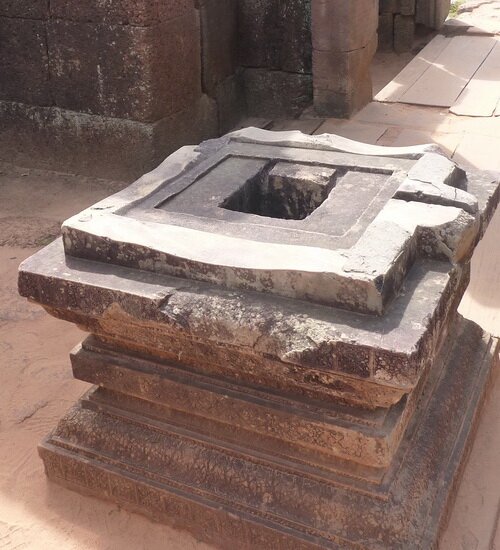 |
 |
|||
|
There are different linga inside each chamber. Most of them are without central "male" element. The mark 6 |
||||
|
After exit from gopuram is remains of Nandin bull, drive animal (vakhana) of Shiva, in sitting position The mark 7 |
|
|||
Eastern gopura of inner enclousure |
||||
|
The East-facing pediment of gopuram depicts Shiva Nataraj - multi-armed got in the dance of the rhythm of life which culminates in destruction at the end of a kalpa or world cycle. At his feet are a drummer and an emaciated Kareikkalammeyar - his disciple. The mark 8 |
032 The West-facing pediment depicts Shiva's consort in her terrible form - Durga, dancing on a bound demon in the form of a lion. Underneath, the lintel depicts avatar of Vishnu as a horse Hayagriva holding the heads of demons Madhu and Kaitabha who stole the Vedas from Brahma . The mark 9 |
|||
Inside inner enclosureSouthern Library |
||||
 |
Eastern pediment - Ravana shakes Kailasa Mounting
|
|||
|
Western pediment - Kama shoots Shiva God of love (3) Kama shoots Shiva (1) to ignite the fire of the love to Parvati in his heart that they will produce children the same perfect ascetics as he is. Actually, it happened during the meditation on Mount Kailash and here he gives her a rosary. Siva noticed this on time and incinerated Kama-deva by his third eye. Ascetics on the Mount Kailash (4). Praying with animal heads (5) ( often in Angkor). On the bottom row of bull Nandin (6), and ordinary people with their animals (7). On the plan The mark 11 |
see in full definition without numbers (3,5 Mb) 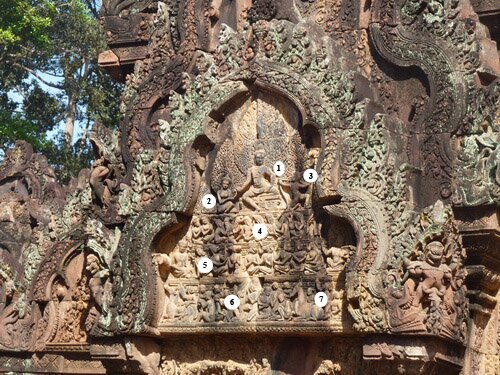
|
|||
Northern Library |
||||
|
Indra and Arjuna (his son) each obliged by their promises and Dharma going to struggle that may to destroy the whole world while Krishna interfered and convinced Indra that the Pandavas are right and he must to help them to build the city named in his honor Indraprastha and fire god Agni has made for Ardjuna his great bow Gondiva from magic derived from the Khandava forest. |
Eastern pediment - Fire in Khandava Forest Preface: When disagreements in Hastinoapure capital between Padavas and the Kauravas became insurmountable the keeper of the throne of Khastinopour Bhishma and Minister Vedura decided to divide the kingdom of Hastinapour between the Pandavas and the Kauravas. Devout Crown Prince of the Pandavas Yudhidshhera to avoid further antagonism choose for Pandavas most lifeless Khandavaprasthu province inhabited by Nagas (snakes) and Rakshasa (demons eaters of human flesh). The king of Nagas Takshaka reigned in this province with the support of the god Indra who promised will not pouring a rain on that province for it may be suitable only for snakes. The Pandavas brothers: Yudhisthira, Bhima, Arjuna, Nakula and Sakhadeva offered Takshaka respect and suggest to live together that he rejected. The forest was bewitched by a Mayasura demon and Arjuna called up the fire god Agni by his arrows to cover by fire the forest just to clean it from magic without bringing a harm to trees and inhabitants (6). Further events is depicted in bas-relief of pediment. Takshaka (5) forced Indra to fulfill his promise to protect Khandava forest (8). Indra on his three-headed elephant Airavata (2) unleashes torrents of rain (3) on Khandava forest(8) for extinguish the fire but Arjuna (1) obstructs the rain by his arrows (4). The two children's figures (7) in the middle of barelief are considered to be unknown but some time before they were considered as Krishna and Balarama in childhood. |
|||
|
|
||||
|
Western pediment - Krishna kills King Kamsa. This scene has been taken from the Srimad Bhagavatam 10.44. The action takes place in the palace. Two large figures presented in perspective that is rare in the bas-reliefs of Angkor. Krishna holds Kamsa's hair and going to kill him in the palace which ones gives us an idea how was beautiful wooden palaces at Angkor. In the corners, apparently, Krishna and Arjuna armed by bow and arrows on the chariot pulled by horses are coming into the palace. In the other rooms depicted excited woman watching on happening. The mark 13 |
||||
|
|
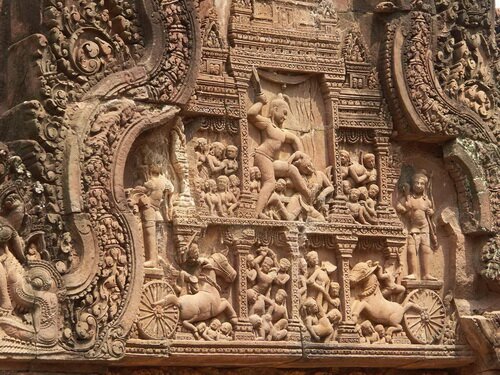 |
|||
Central Sanctuary |
||||
Eastern entrance to the mandapa
Indra rides a three-headed Airavata. Mark 14 |
Western pedimentsee in full definition (3,8 Mb) Varuna on geese is on pediment. The lintel depicts the scene from the Ramayana showing Ravana abducting Sita - wife of Rama. The mark 18 |
|||
Northern pedimentsee in full definition (3,3 Mb) Pediment: Rahu devours an elephant. The lintel and pediment has a typical filling by foliage for depiction of Rahu. The mark 21 |
see in full definition (3,9 Mb)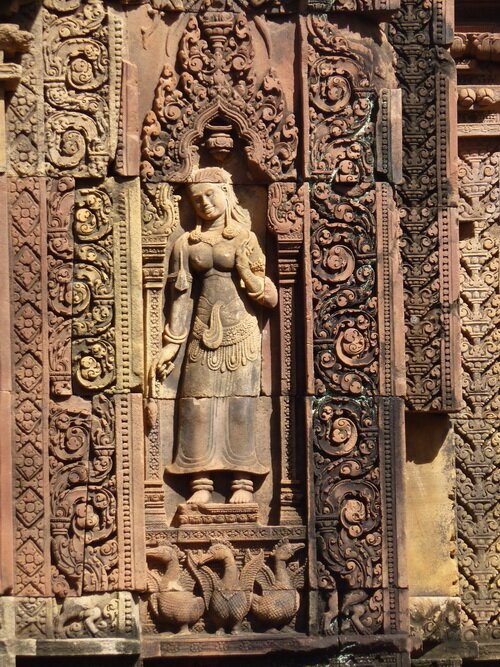 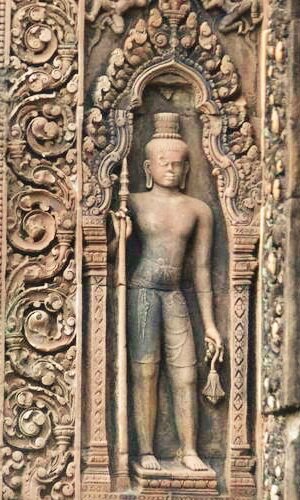 Magnificent Apsaras and guardians standing in niches on all facades. |
|||
Southern Sanctuary |
||||
East-facing pediment
Shiva and Uma are riding on Nandin at pediment and Indra rides on the three-headed Airavata on the lintel. The mark 15 |
South-facing pedimentsee in full definition (3,6 Mb) Yama - God of the South direction as well as the Judge after death on a buffalo both on the pediment and on the lintel. The mark 16 |
|||
Northern sanctuary |
||||
North-facing pedimentsee in full definition (4,5 Mb) Pediment: Kubera - Got of wealth and North direction on a throne, representing the magic chariot Pushpaka, supported by three lions. |
West-facing pedimentsee in full definition (3,4 Mb) Pediment: Varuna - God of western direction and god of World Ocean on three gooses - Hamsas. |
|||
|
Monkeys guard the entrance of the sanctuary |
View on the west side of sanctuaries |
|||
The western gopura |
||||
|
Battle between Valin and Sugriva. . The scene from the Ramayana: Valin (the son of Indra) despoiled Sugriva's (the son of Surya - the Sun God) kingdom of monkeys. Rama promised to help him to return the kingdom in exchange for helping of monkeys kingdom army led by Hanuman against the army of Ravana to release Sita - the wife of Rama. During the fight Sugriva going to defeat but Valin resorted to tricks, pretending to be dead and was ready to deal a fatal blow to Sugriva but Rama (to the right armed by bow) pierced him by arrow. Behind him, it seems, his brother Lakshman. The mark 22 |
see in full definition (5,3 Mb) 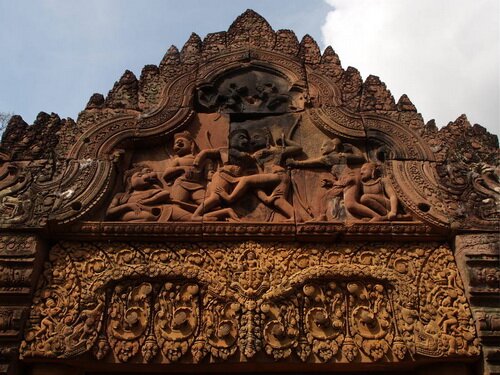
|
|||
|
View to Banteay Srei from western gopuram. |
||||
 |
||||
| been used stuff of books Maurice Glaize "Angkor"; Michael Petrochenko "Angkor Temples"; Claude Jacques, Michael Freeman "Angkor Cities and Temples" and "The Monuments of Angkor Group" by Maurice Glaize | ||||
